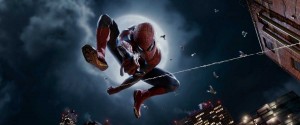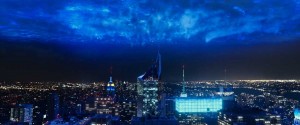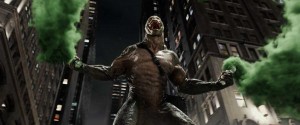
Typically, Smith is the go-to craftsperson who supports the overall visual effects supervisor of a project during principal photography. “I am maybe running second unit or getting first shot tests up and running,” he said. “I am involved with early design work, [getting elements] built out so that it can be presented while they are shooting. Sometimes, we work with the previz teams to design how the shots will come together.”
On the new Spider-Man, there was no such time when Smith was brought on to work with Jerome Chen, the film’s visual effects supervisor. After principal photography wrapped, Chen was consumed with supervising the myriad effects shots, spread across 13 vendors including Sony Pictures Imageworks. “He was working over at the production offices with the director, editors and producers, and I was here at SPI getting our team rolling,” described Smith. “ I was working under Jerome and the director, getting direction to get everything rolling.”

Though a number of shots were either started or completed but didn’t make the final cut, Smith oversaw 202 fully digital shots and 240 shots with the lizard character out of SPI’s 670 shots. “We did a number of shared shots – 20-25 with us and other vendors, which is typical now,” he said. “We composited elements in shots, plus we did completely digital shots. When you are making fully digital characters, living and breathing close up and interacting with the environment and themselves, the key is getting a soul into the characters.”
Though the Spider-Man character himself wears a mask, the titular character as played by Andrew Garfield brought many nuances to the performance, necessitating that SPI had to ensure that the digital version and the live-action version were one and the same. “We recorded data of Andrew Garfield in his signature poses, studying his movements and the way he posed his fingers when he crouched down or crawled on the wall,” Smith detailed. “We wanted to make you feel like there is something there deep inside. For the lizard, you saw his eyes and face. People read a lot of soul through the eyes.”
For the aforementioned lizard, as portrayed by Rhys Ifans, there was a fiberglass maquette made of the lizard design to give the SPI artists a base from which to begin their work. “We infuse life into it,” Smith stated. “We used reference photography of Rhys Ifans so that we can fuse characteristics of his brow and eye area. His physiology did not match the lizard character, so we studied his actions and reference [footage] of him performing as if he were the lizard. Animators go off of there to get reference for the movement of the character on a nine-foot-tall 800-pound lizard character.”
 Additionally, the SPI technicians studied the motion of large lizards, including the Komodo dragon. “We had to get the skin and muscles of a lizard into a humanoid bipedal character,” Smith recalled. “We got the way that the skin would be leathery and fold and the way that the lizard moves his tail from studying large lizard families. We wanted a depth to him deeper inside than his surface movement.”
Additionally, the SPI technicians studied the motion of large lizards, including the Komodo dragon. “We had to get the skin and muscles of a lizard into a humanoid bipedal character,” Smith recalled. “We got the way that the skin would be leathery and fold and the way that the lizard moves his tail from studying large lizard families. We wanted a depth to him deeper inside than his surface movement.”
Because lizards have a complex internal structure, Smith’s team needed to create a procedural shake and jiggle to the muscles in their digital character’s arms. “All that kind of control is given to the animator for movement deep inside the outer skin,” Smith remarked. “We have an additional team to go in and finesse the muscle movement to get an organic feel to it and animate his skin with a leathery armor quality on the outside and a soft quality towards his belly and the front of his neck.”
To realize their 3D lizard creature, SPI staffed a team of three modellers, two texture painters, one rigger and a support team of six animation support and animators, all dedicated to make the complex character work. “They defined the animation of the creature before we got into the shots needed for the film,” Smith elaborated. “We get up to 60-70% of the way there and that same team gets the character into the first group of shots. Nobody [in production] takes full consideration of what we’ve done until they see the lizard in a few key defining shots for the character. Those are the ones that we work on first. That will take 10 times longer than it will to get a normal shot through.“
Once production approves a character in those first sample shots, Smith takes his SPI artists through the finishing touches on lighting and action, putting the digital character through his paces in the actual shots. “Whenever we see the lizard, he is fully digital,” Smith said. “ At the very end of the film, we created a few shots where he is transforming back to the Curtis Connors character. Some of the other vendors handled shots of him mutating into the lizard.”
For Smith, a day at work at SPI involved prioritizing. “’What’s the most important things to get done, established, and in front of the director first?’” he asked. “Those are the shots that are going to define the film. On this film, we have matured as a craft, and we had a very strong leadership team that helped those 440 people. That kind of experience on other shows really helped with schedules getting shorter and shorter. I have a team of four CG supervisors each looking out for 40-45 of the artists. We have teams that have been built up over the years with technology behind them. We have a core group to get the new people up and running quickly.”
Although Smith had not worked on any of the three preceding Spider-Man movies, he instead looked to what was available to him as a digital artist at present. “The main thing was to bring a fresh approach with a new director and visual effects supervisor,” Smith claimed. “We had some team members who sourced their knowledge of the previous films.”
One new element with The Amazing Spider-Man was the decision to shoot in 3D stereo, with two digital cameras on the action at all times so that both “eyes” were captured. “In the past, we generated both eyes here at SPI, and other shows where we have converted the photography into 3D,” Smith said, “but it doesn’t have the natural beauty of stereo which helps immerse you in the film.”
With software tools such as a new physically-based renderer that SPI co-developed and a lighting package called Katana which was created in 2004, Smith had much at his disposal. Additionally, the digital team used software available on the open market, such as Maya for front-end work, including modeling and animation. Nonetheless, Smith’s 18 months on The Amazing Spider-Man was packed with days that would run from early in the morning to fairly late at night. “There’s a lot of work to look at and adjust,” he said of his daily schedule. “We sit in a dark room looking at the movie on video screens, not seeing much of the light of day. I think when the final film gets a good response, that makes it all worth it. Hopefully we can apply these technologies to the next level in the future.”





